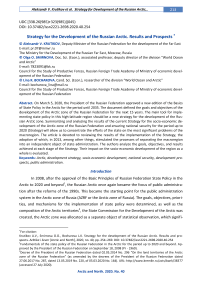Strategy for the development of the Russian Arctic. Results and prospects
Автор: Krutikov Aleksandr V., Smirnova Olga O., Bocharova Lina K.
Журнал: Arctic and North @arctic-and-north
Рубрика: Northern and arctic societies
Статья в выпуске: 40, 2020 года.
Бесплатный доступ
On March 5, 2020, the President of the Russian Federation approved a new edition of the Basics of State Policy in the Arctic for the period until 2035. The document defined the goals and objectives of the development of the Arctic zone of the Russian Federation for the next 15 years. The main tool for implementing state policy in this high-latitude region should be a new strategy for the development of the Russian Arctic zone. Summarizing and analyzing the results of the current Strategy for the socio-economic development of the Arctic zone of the Russian Federation and ensuring national security for the period up to 2020 (Strategy) will allow us to concentrate the efforts of the state on the most significant problems of the macroregion. The article is devoted to reviewing the results of the implementation of the Strategy, the adoption of which, in 2013, among other things, stimulated the processes of separating the macroregion into an independent object of state administration. The authors analyze the goals, objectives, and results achieved at each stage of the Strategy. Their impact on the socio-economic development of the region as a whole is evaluated.
Arctic, development strategy, socio-economic development, national security, development prospects, public administration
Короткий адрес: https://sciup.org/148318386
IDR: 148318386 | УДК: [338.26(985)+323(985)](045) | DOI: 10.37482/issn2221-2698.2020.40.254
Текст научной статьи Strategy for the development of the Russian Arctic. Results and prospects
In 2008, after the approval of the Basic Principles of Russian Federation State Policy in the Arctic to 2020 and beyond1, the Russian Arctic once again became the focus of public administration after the reforms of the 1990s. This became the starting point for the public administration system in the Arctic zone of Russia (AZRF or the Arctic zone of Russia). The goals, objectives, priorities, and mechanisms for the implementation of state policy were determined, as well as the composition of the Arctic territories2, the State Commission for the Development of the Arctic was created, the Arctic zone was allocated as a separate object of statistical observation, which signifi-
∗ For citation:
Aleksandr V. Krutikov et al. Strategy for Development of the Russian Arctic… cantly contributed to the improvement of the quality of monitoring the achievement of the set development goals and improving the quality of life of the population in the macroregion.
In pursuance of the Fundamentals of State Policy in the Arctic in 2013, the Development Strategy of the Arctic zone of the Russian Federation and National Security for the period up to 2020 was approved3 (the Strategy). In 2014, the State program of socio-economic development of the Russian Federation's Arctic zone was adopted as a tool for implementing the Strategy4.
The development and approval of these documents were timely. By 2010 – early 2011, all the Arctic states with access to the Arctic Ocean worked out documents aimed at developing their Arctic territories and defining Arctic priorities, to one degree or another. The first scientific discussions on these documents' content appeared [1, Brosnan J.G., Leschine T.M., Miles E.L.].
So, in 2006 Norway presented a development program for the northern territories – “New Building Blocks in the North”5 . In 2009, a new version of this program was adopted, and a plan for its implementation was formed. According to these documents, Norway planned to increase its efforts in the region, primarily in scientific research. Denmark had developed its strategy for the Arctic6 in May 2008; its primary goal was to strengthen Greenland's autonomy while maintaining the role of Denmark as one of the key players in the region. According to Canada's northern strat-egy7, adopted in 2009, this Arctic state is focused on strengthening Canada's sovereignty, the socio-economic development of the northern territories, and protecting the fragile nature of the Arctic and the development of self-government of peoples inhabiting northern Canada. Presidential Directive on National Security 8 in 2009, a new US Arctic strategy was adopted. During the same period, the Arctic Council member countries (Iceland, Finland, Sweden) and observer countries in the Arctic Council, China, and India, developed their Arctic strategies. It should be noted that the strategic documents of the four Arctic coastal states, in contrast to the Russian Arctic Strategy, directly noted the need to achieve leadership in the region.
As a result, various models for managing the development of the Arctic spaces were created, which differ in many characteristics (the scale of the territories, physical-geographical and natural-climatic features, various models of the administrative-territorial and state structure, the level of socio-economic development of the Arctic territories, etc.). At the same time, the European countries that are part of the Arctic Council believe that the solution of the main development problems of this macroregion, unique in many respects, is possible only with the participation of the largest countries - world leaders, such as China, India, Japan, the Republic of Korea [2, Zaikov K.S., Kondratov N.A. et al.].
This year, the implementation of the Russian Arctic Development Strategy is coming to an end. Summing up, analysis and critical, realistic assessment of the achieved results are the basis for the development of a new Strategy for the development of the macroregion, which will act as an instrument for the implementation of the Fundamentals of State Policy of the Russian Federation in the Arctic for the period up to 20359.
The first results of the implementation of the Strategy of social and economic development of the AZRF
In the first decade of the twentieth century, the AZRF had to face such threats as the outflow of labor resources, the low quality of life of the indigenous minorities, the low population density and its uneven distribution, the lack of technologies for the development of new deposits, the aging of the icebreaker fleet, the lack of means of constant, integrated space monitoring, etc.
In this regard, the strategy's implementation was planned in two stages, the first of which ended in 2015. During this period, it was planned to increase the efficiency of state management of the region, develop a system of economic incentives, including support for indigenous peoples, create an information and telecommunications infrastructure, and ensure a favorable operational regime, create an integrated security system to protect against natural and human-made emergencies, ensure the elimination of environmental damage and take other measures to ensure environmental safety in the Russian Arctic. The continuation of scientific research, including the substantiation of the continental shelf's outer boundary, was also set as priorities.
As noted above, during this period, the foundation was laid for the Russian Arctic state administration system. Thus, by the Decree of the President of the Russian Federation dated February 03, 2015, No. 50, the State Commission for the Development of the Arctic was established. This body's tasks include ensuring the coordination of state authorities' activities and local selfgovernment in solving the problems of development of this high-altitude region.
The National Security Strategy of the Russian Federation, approved in 2015, focuses on the need to solve strategic tasks in the Arctic 10. An equally important document for the development of the region is the Maritime Doctrine of the Russian Federation 11, which defines a wide range of tasks for developing marine activities in the Arctic latitudes. In the same period, indicators of the development of the Arctic zone of the Russian Federation and, in particular, the Strategy for its development were included in the Federal Plan of Statistical Work. Thus, the AZRF was singled out both as an object of state administration and as an object of statistical observation.
In addition to improving the regulatory framework for the macroregion development, significant results have been achieved in the first years of the Strategy implementation. The Comprehensive Project for the Development of the Northern Sea Route was approved. Reconstruction of its base and support ports (Murmansk and Arkhangelsk) began. The construction of the seaport of Sabetta on the Yamal Peninsula was continued, the Arctic Gate oil terminal was launched. As part of the development of transport support, the modernization of airport complexes (Naryan-Mar, Pevek, Norilsk, etc.), automobile and railway infrastructure has begun. In the same period, measures were taken to renew the icebreaker fleet: icebreakers were put into operation, capable of breaking ice up to 1.5 meters thick. A decision was made to build new nuclear icebreakers for project 22220. These icebreakers' capacity will allow breaking ice up to 3m to conduct caravans of ships with a deadweight of up to 100 thousand tons and to fully important function in the mouths of Arctic rivers.
A large-scale work was carried out to eliminate the accumulated environmental damage, including the environmental clean-up of military units. Besides, the formation of a production waste management system and creating specially protected natural areas in the Russian Arctic have begun. Work has been carried out to expand existing and create new, specially protected natural areas.
At the first stage of the Strategy implementation, remote sensing space constellation has begun.
The largest project in Russia's Arctic zone was Yamal LNG, the active implementation of which began in 2013. The project includes the construction of a new seaport of Sabetta and an airport and the creation of a natural gas liquefaction plant with a capacity of 16.5 million tons.
It should be noted that the Arctic strategies of states having access to the Arctic Ocean and claiming active economic activity in the region are based on forecasts of significant reserves of natural resources and are associated with the prospects for their industrial development. [3, Pavlenko V.I., Melamed I.I., et al.]. Simultaneously, in comparison with other Arctic coastal states, the most powerful industrial base has been created in the Russian part of the Arctic. The share of mining enterprises in the domestic, regional product created in the Russian Arctic is about 60%, while it does not exceed 30% in Canada and Alaska. In the northern European countries, which belong to the Arctic, this figure is at the level of 15%. At the same time, according to the characteristics of the quality of life, the Arctic zone of Russia lags significantly behind the other Arctic and subarctic states. For example, in terms of the population's income level in terms of purchasing power parity, Russia is 2 times behind the Arctic regions of Denmark, 3 times less than Norway and Canada, and 4 times less than the USA [4, Zalyvsky N.P.]. This lag has led to challenges to the Russian Arctic's sustainable development and to ensuring Russia's national security in the Arctic.
And at present, this lag has not been radically reduced. However, it should be noted that over the years of the implementation of the Strategy, the level of socio-economic development of most of the Arctic territories shows positive dynamics.
Several planned tasks remained unresolved or incompletely resolved at the end of the strategy implementation stage. Thus, a regulatory legal framework has not been formed that comprehensively covers the region's development issues, including regulating the preservation of the traditional way of life of the indigenous and small-numbered peoples of the North, Siberia, and the Far East. Difficulties arose with the construction of the icebreaker fleet and other types of vessels required for the AZRF. The modernization of the port infrastructure was not efficient enough; there was still poor coordination and support for delivering goods to the Far North and Arctic territories. Difficulties also arose with the development of domestic Arctic technologies, which largely determined foreign partners' attraction to the implementation of large investment projects. Thus, during the implementation of the Yamal LNG project, large orders for developing the necessary equipment were placed at Chinese enterprises that did not have experience in such production 12. The formation of new technological competencies in Chinese contractors was financed.
According to experts 13, by 2015, it was impossible to form the primary conditions for further developing the Arctic zone of Russia [5, Minakir P.A., Leonov S.N.].
One of the reasons for such an ineffective start in implementing the strategy was the lack of the necessary resources. According to the Federal Law of the Russian Federation “On Strategic Planning in the Russian Federation” 14, the actual instruments for implementing strategies are government programs. At the same time, the State program “Socio-economic development of the Arctic zone of the Russian Federation”, approved in 2014, was analytical and did not imply the allocation of independent funding [6, Smirnova O.O.]. Its implementation was planned through activities included in other state programs. Several key tasks of the Strategy did not find their solution by the program-target method; some tasks were solved only partially. The activities of various state programs did not cover the entire range of tasks defined by the Strategy for the Development of the Arctic Zone and the Fundamentals of State Policy of the Russian Federation in the Arctic for the period up to 2020 and beyond. Even in their totality, the events within the framework of the State Program “Social and Economic Development of the Arctic Zone of the Russian Federation” did not become an instrument for implementing strategic planning documents for the development of the region. It should be noted that it is in this high-altitude region that the provision of socio-economic development and national security are maximally interconnected. First of all, this concerns the issues of infrastructure development, the development of Arctic technologies, the intensification of scientific research, which will allow our country to increase technological and intellectual presence in the region [7, Kudryashova E.V.].
Development of the Arctic zone of Russia 2015–2020
At the second stage of the strategy implementation, it was planned to transition to the sustainable, innovative social and economic development of the region. By 2020, the tasks of transport support for the Arctic regions, as well as Eurasian transit through the construction of iceclass ships and support ships, and the development of the infrastructure of the Northern Sea Route, were to be solved. Besides, the anthropogenic load on the Arctic region's environment had to be reduced, measures were taken for environmentally efficient nature management, including the sustainable use of aquatic biological resources. Equally important tasks were in information support for the development of the Arctic zone, including the creation of information and telecommunications infrastructure, the development of radio navigation systems, the development of an integrated security system against threats of emergencies, and much more.
However, the implementation of the first stage made it necessary to adjust the measures taken. So, by the beginning of the second stage, the necessary regulatory legal framework was not fully formed, stimulating the development of the Arctic zone of Russia and regulating the preservation of the traditional way of life of the indigenous and small peoples of the North, Siberia and the Far East. As before, the development of normative tools was required to modernize life support systems for the region's population and ensure the delivery of goods to the Far North regions. The postponement of the planned construction dates for icebreakers, which was primarily due to the system-wide problems of domestic shipbuilding, was a constraining factor in developing the cargo base of the Northern Sea Route. Problems in the field of Arctic shipbuilding acted as a marker signaling the most complex problems in the implementation and development of advanced technologies adapted to the Arctic conditions, as well as the introduction and use of dual-use technologies in the interests of comprehensively addressing defense, security, and sustainable socio-economic development of the Arctic zone. Russian Federation.
To meet the challenges in August 2016, the Strategy implementation plan was approved 15, which contained 80 items, grouped according to main priority areas. A year later, in 2017, the state program was also adjusted 16, which defined and consolidated a new approach to implementing state policy in the Russian Arctic. The subprograms are focused on three key problems of the region's development: the development of the Northern Sea Route and the creation of domestic equipment to develop mineral resources of the Russian Arctic. The main innovation of the updated state program was the definition of support zones for development as the primary tool for stimulating the Arctic region's socio-economic development. At the same time, its funding from the federal budget was fixed in the state program, which gave a certain impetus to the macroregion's development.
Summing up the results of implementing the second stage and the entire Strategy, we can confidently note that significant results have been achieved.
For investors working in the Arctic zone, a system of preferences has been formed aimed at stimulating the implementation of new investment projects in the Arctic zone of the Russian Federation. The President of the Russian Federation signed a package of relevant laws 17. Any entrepreneur registered in the Arctic who is ready to implement a new investment project and invest at least 1 million rubles can become a resident of the Arctic zone 18. Resident status implies several tax benefits and non-tax preferences. They are also provided for by the new edition of the Tax Code of the Russian Federation 19. These benefits and preferences aim to enhance the exploration and assessment of hydrocarbon deposits and stimulate their production in the Arctic.
In the development of the fuel and energy complex, work has been completed to extend the Kola NPP's life in the Murmansk Oblast. The commissioning of a floating nuclear power plant in the town of Pevek in the Chukotka Autonomous Okrug, the construction of which began in 2008, is nearing completion. At present, a power plant has been commissioned, and hydraulic structures and coastal infrastructure facilities. New facilities of the coastal network were built to launch the station, providing communication between the station and the high-voltage networks of the Chukotka Autonomous Okrug. In June 2020, the station was connected to the heating networks of Pevek 20.
As part of the transport infrastructure development, the construction of the Utrenniy liquefied natural gas terminal has begun, facilitating the development of the Salmanovsky (Utrenny) oil and gas condensate field on the Gydan Peninsula of the Yamal-Nenets Autonomous Okrug. This field should become the resource base for the Arctic LNG 2 project. Also, the reconstruction of the sea channel in the Ob Bay has begun. The construction of a coal terminal “Chaika” (Krasnoyarsk Territory) in the port of Dikson is also underway. The terminal will make it possible to develop the Syradasayskoye coking coal deposit in the Lemberov River region, Taimyr Dolgano-Nenets municipal district of Krasnoyarsk Territory.
Despite the postponement of the commissioning of new nuclear icebreakers, their construction is at the final stage. In June 2020, it is planned to commission the lead icebreaker Arktika. Two subsequent serial universal nuclear icebreakers are to be commissioned by 2022. In 2019, FSUE Atomflot and JSC Baltiyskiy Zavod signed an agreement to construct the third and fourth serial universal nuclear icebreakers of project 22220; their delivery is scheduled for December 2024, and December 2026 21. Besides, since 2010, 34 units of rescue vessels have been admitted to the rescue fleet. Currently, the construction of 4 more vessels of the rescue fleet is underway.
It is impossible not to note the changes in the healthcare sector in the Russian Arctic. During the implementation of the Strategy, a gradual modernization of the material and technical base of health care in the subjects whose territories belonged to the Arctic zone was carried out: deliveries of ambulances were carried out, 35 paramedic and obstetric points were opened in 2019, as well as five outpatient oncological care centers. Telemedicine technologies are actively developing; about 100 medical organizations of the Russian Arctic are connected to the Russian Ministry of Health's telemedicine system. If in 2016, about 115 telemedicine consultations were carried out, then in 2019, almost 8 thousand such consultations were carried out. Medical aviation continues to develop, which is carried out to provide emergency medical assistance to citizens living in remote areas of the Russian Federation. As part of the implementation of the priority project “Development of medical aviation”, which ended in 2019, new aircraft were used, produced in Russia, and equipped with a medical module.
The results achieved in the healthcare sector significantly influenced life expectancy in the Russian Arctic from 70.65 years in 2014 to 72.39 years in 2018 (Fig. 1)
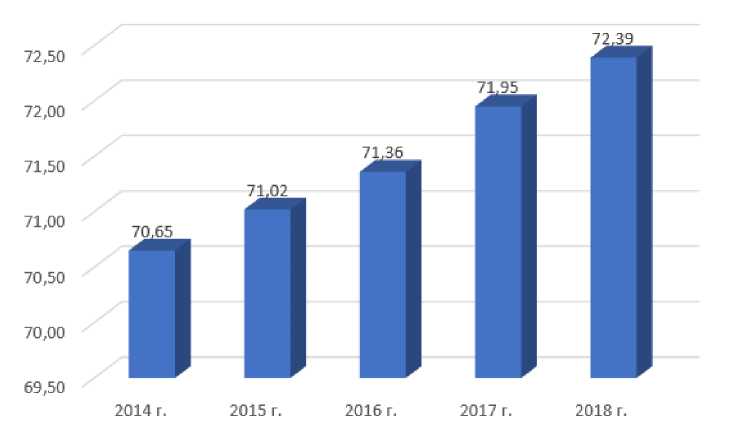
Fig. 1. Life expectancy at birth, years
Also, according to Rosstat data, the rate of natural population growth is consistently decreasing in the Arctic zone (Fig. 2). Against the background of relatively stable figures, the number of people who left the region at the level of about 140 thousand people a year indicates the aging of the Russian Arctic population.
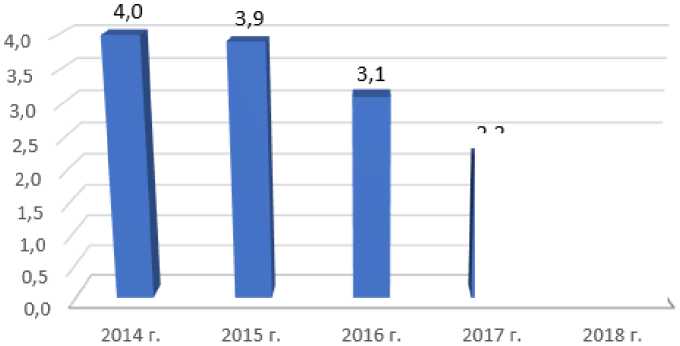
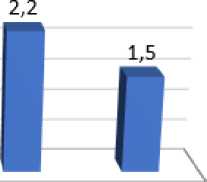
Fig. 2. Dynamics of the rate of natural population growth (2014-2018) 23.
However, according to which the natural population growth rate in 2018 was -1.6, the AZRF coefficient of 1.5 looks good compared to the all-Russian data. At the same time, if we study the dynamics of this indicator for 2018 in the context of the territories of the Russian Arctic, then the leader in the birth rate growth is the Yamal-Nenets Autonomous Okrug, which is explained by the attraction of labor resources for the development of hydrocarbon deposits (11.8 in 2014, 8.7 in 2018). The most significant decrease in the rate of natural increase is observed in the Republic of Karelia (-13 in 2018) and the Arkhangelsk Oblast (-2.3 in 2018). In this regard, it can be assumed that one of the tasks of state policy in the Arctic region should be at least maintaining such indicators of natural population growth as a whole in the Russian Arctic and increasing this coefficient in regions where it is significantly lower than the all-Russian values.
It should be noted that during the period of implementation of the Strategy, the migration outflow of the population, as the difference between the arriving and leaving population, decreased by 53% from 22,835 people in 2015 to 12,335 people in 2018. Also, the largest migration outflow in 2018 was observed in the territories referred to as the Russian Arctic, in the Republic of Karelia and the Republic of Komi per 1,000 people of the resident population (-15.4 and -34.3, respectively). At the same time, the number of the resident population in the Russian Arctic remains at the level of 2.4 million people (Fig. 3), and the negative trend of decrease in the number was reversed.
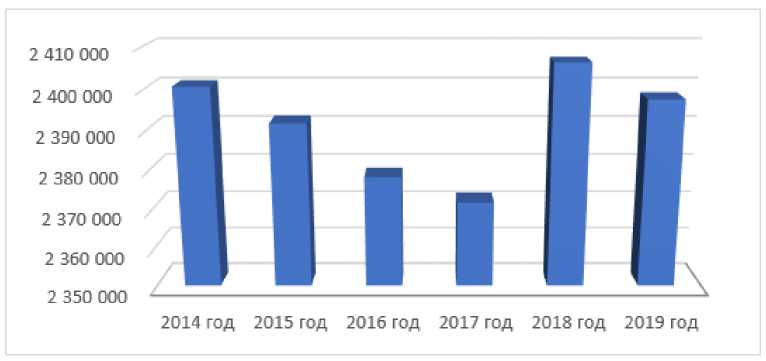
Fig. 3. Dynamics of the resident population of the Arctic zone of Russia, million people 24.
This is largely due to the creation of new jobs, which positively affected the unemployment rate, which decreased from 5.6% in 2017 to 4.6% in 2019 (according to the methodology of the International Labor Organization). This, in turn, was one of the factors in the increase in the share of the gross regional product produced in the Russian Arctic in the total gross regional product of the constituent entities of the Russian Federation from 5% in 2014 to 6.2% in 2018 (Fig. 4).
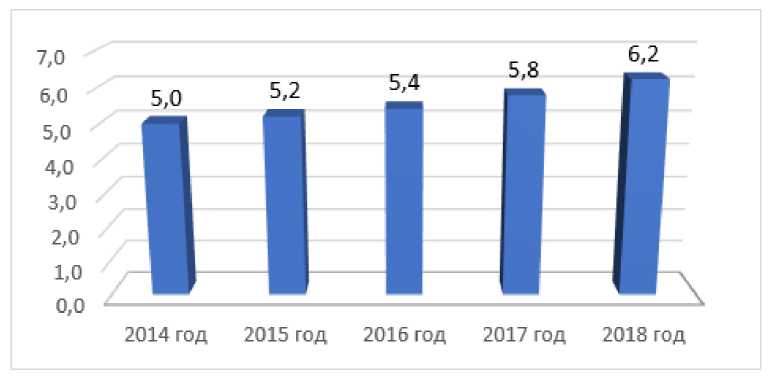
Fig. 4. Dynamics of growth in the share of gross regional product produced in the Arctic zone of the Russian Federation, percentage 25.
This was facilitated by an increase in the share of budgetary funds (budgets of all levels) in the total volume of investments in fixed assets in the Arctic zone from 5.5% in 2014 to 7.6% in
2019. Current expenditures on research and development have also increased from 4.3 billion rubles in 2016 to 4.6 billion rubles in 2018. However, the share of the added value of high-tech and science-intensive sectors of the Russian Arctic economy's economy decreased slightly from 7.5% in 2016 to 6.1% in 2018.
The growth rate of the Arctic region's development is also evidenced by the growth in traffic volumes along the Northern Sea Route, which has grown by almost 8 times compared to 2014 (Fig.5).
-
24 Rosstat data. Compiled by the authors.
-
25 Rosstat data. Compiled by the authors.
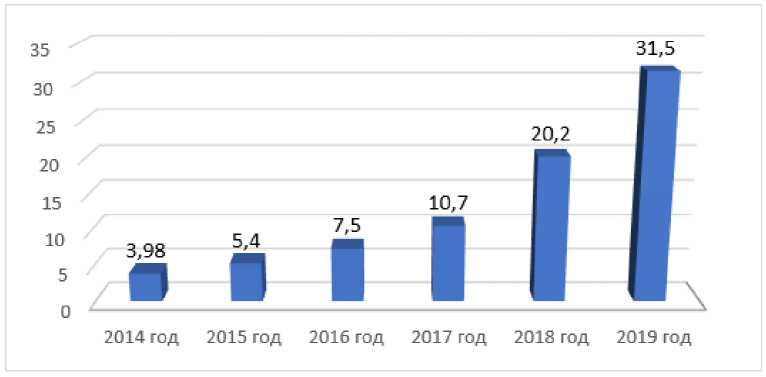
Fig. 5. Dynamics of traffic volumes along the Northern Sea Route, million tons 26.
At the same time, the volume of cargo transshipment in the ports of the Arctic Basin increased almost 3 times (Fig. 6), which indicates the prevalence of export cargo. On average, such cargoes make up about 77%, and coastal ones - about 10%. Such an increase in export traffic along the Northern Sea Route ensured an increase in the transportation of liquid cargo associated with hydrocarbon deposits.
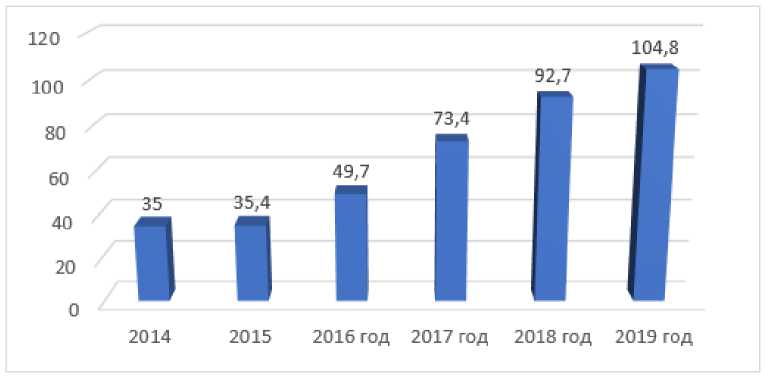
Fig. 6. Dynamics of the volume of cargo transshipment in the seaports of the Arctic basin, million tons 27.
At the same time, several negative trends and risks remain in the field of socio-economic development and ensuring national security in the Russian Arctic:
• a decrease in the natural growth rate of the population of the Russian Arctic by 2.5 times from 4.0 in 2014 to 1.5 in 2018, which, together with the ongoing migration outflow, forms a stable trend towards a decrease in the population of the region;
• a high percentage of emergency housing against the background of low volumes of housing stock construction, an insufficient level of availability of high-quality social services, an increase in wage arrears from 26.8 million rubles in 2018 up to RUB 162.1 mln. (as of January 1, 2020, which affects 2 thousand people) create the basis for high risks in the social sphere;
Rosstat data. Compiled by the authors.
Open media data. Compiled by the authors.
-
• the delay in the development of the infrastructure of the Northern Sea Route, the postponement of the construction of icebreaker and other types of fleet from the planned ones gives rise to risks of failure to achieve the set national development goals defined by the decree of the President of the Russian Federation of May 7, 2018, No. 204 “On national goals and strategic objectives of the development of the Russian Federation for the period up to 2024”, and also hinders the implementation of other investment projects in the region;
-
• a decrease in the added value of high-tech and knowledge-intensive sectors of the economy in the Russian Arctic gross regional product from 7.5% in 2016 to 6.1% in 2018. Against the background of strengthening sanctions regimes and setting targets for the development of domestic technologies for Arctic projects, concerns are raised by the fact that that the financing of the subprogram “Creation of equipment and technologies for oil and gas and industrial engineering required for the development of mineral resources of the Arctic zone of the Russian Federation” will begin in 2021, and then subject to the allocation of additional budgetary allocations from the federal budget [8, Kudryashova E.V., etc.]
It should be noted that the Ministry for the Development of the Far East and the Arctic is developing a draft of a new Strategy for the development of the Arctic zone of the Russian Federation and ensuring national security for the period up to 2035. It can be assumed that in the new version of the Strategy until 2035, these and other negative trends should be considered, and measures should be formulated to neutralize them.
Conclusion
In recent decades, the Arctic has been undergoing significant transformations, driven by climate change. This gives rise to a change in the tactics and development strategy of both the Arctic states and countries geographically located outside the region. Analysis of ongoing processes and determination of the region's development prospects form the choice of state policy instruments in the Arctic [9, Schach M., Madlener R.]. Moreover, this circumpolar region's development is always a compromise between the need to ensure environmental protection and adaptation to the consequences of climate change and the need to develop economic activities [10, Hein-inenn L.]
Compared to 2013, the development objectives of the Arctic zone have not fundamentally changed. This is a comprehensive socio-economic development, the intensification of scientific research, the development of advanced Arctic technologies, the formation of various infrastructure (from energy, transport to information and telecommunications), ensuring environmental safety and preserving the Arctic as a zone of peace through the development of international cooperation. However, over the past years, the emphasis has shifted somewhat. If in the early
2010s, the task was to create a lot of new, then in the early 2020s, the task is to develop and improve what has been achieved.
In 2019, the President of the Russian Federation, in his speech at the Arctic – Territory of Dialogue International Forum, noted that “a new strategy for the development of the Russian Arctic until 2035 should combine the activities of Russian national projects and government programs, investment plans of infrastructure companies, programs for the development of the Arctic regions and cities”28.
At the same time, the development of the Arctic spaces is impossible without the population permanently living in the region. All Arctic states “rely” on their permanent population strategies, and Russia is no exception. In this regard, we believe that ensuring the quality of life at a level not lower than the national average and achieving the average Russian values of key socioeconomic indicators should be one of the strategy's key goals until 2035. At the same time, development issues should consider the specifics of the life of the indigenous peoples of the North.
One of the national development goals for the period up to 2024, determined by the President of the Russian Federation, is to ensure the transportation of goods along the Northern Sea Route in 80 million tons. Achieving such an ambitious goal implies the comprehensive development of the transport sector. And this is not only the construction of icebreaking vessels but also vessels for transporting goods, as well as vessels supporting the corresponding ice class, the development of port infrastructure along the entire length of the Arctic sea route, the development of inland waterways, navigation facilities, meteorological support and much more. It also requires the development of other infrastructure, primarily energy. Infrastructure projects can serve as the basis for attracting additional investments and implementing large business projects.
We believe that the adoption of the new Strategy for the Development of the Arctic Zone of the Russian Federation for the period up to 2035, as well as the adjustment of the State Program “Social and Economic Development of the Arctic Zone of the Russian Federation” will contribute to the continuation of Russia's policy towards the Arctic region.
Список литературы Strategy for the development of the Russian Arctic. Results and prospects
- Brosnan J.G., Leschine T.M., Miles E.L. Cooperation or Conflict in a Changing Arctic? Ocean Develop-ment & International Law, 2011, no. 42, pp. 173–210.
- Zaikov K.S., Kondratov N.A., Kudryashova E.V., Lipina S.A., Chistobaev A.I. Stsenarii razvitiya arktich-eskogo regiona (2020–2035 gg.) [Scenarios for the Development of the Arctic Region (2020–2035)]. Arktika i Sever [Arctic and North], 2019, no. 35, pp. 5–24. DOI: 10.17238/issn2221-2698.2019.35.5
- Pavlenko V.I., Melamed I.I., Kutsenko S.Yu., Tutygin A.G., Avdeev M.A., Chizhova L.A. Osnovnye printsipy sbalansirovannogo sotsial'no-ekonomicheskogo razvitiya territoriy Arkticheskoy zony Ros-siyskoy Federatsii [The Foundations of Balanced Socio-Economic Development of the Territories of Arctic Zone of the Russian Federation]. Vlast' [Power], 2017, vol. 25, no. 6, pp. 7–17.
- Zalyvskiy N.P. Indeks schast'ya v stranakh Arktiki: indeksnoe izmerenie i sopostavlenie dinamiki razvitiya ekonomiki Arkticheskogo mira [The Index of Happiness in the Arctic: Index Measurement and Comparison of the Dynamics of Arctic Economies]. Arktika i Sever [Arctic and North], 2016, no. 22. pp. 43–65. DOI: 10.17238/issn2221-2698.2016.22.43
- Minakir P.A., Leonov S.N. Metodologicheskie problemy prognozirovaniya razvitiya Arktiki Dal'nego Vostoka Rossii [Methodological Problems of Forecasting the Development of the Arctic of the Rus-sian Far East]. Vestnik MGTU [Bulletin of MSTU], 2014, vol. 17, no. 3, pp. 540–551.
- Smirnova O.O. Dialektika arkticheskikh prioritetov [Dialectics of Arctic Priorities]. In: Strategicheskie perspektivy razvitiya Arkticheskogo regiona [Strategic Prospects for the Development of the Arctic Region]. VAVT, 2018, pp. 6–13.
- Kudryashova E.V., Lipina S.A., Zaikov K.S., Bocharova L.K. Arctic Zone of the Russian Federation: De-velopment Problems and New Management Philosophy. The Polar Journal, 2019, vol. 9, iss. 2: Latin America and Antarctica. Pp. 445–458. DOI: https://doi.org/10.1080/2154896X.2019.1685173
- Lipina S.A., Smirnova O.O., Kudryashova E.V., eds. Arktika: strategiya razvitija [Arctic: Development Strategy]. Arkhangelsk, NArFU Publ., 2019, 338 p. (In Russ.)
- Schach M., Madlener R. Impact of an Ice-Free Northeast Passage on LNG Markets and Geopolitics. Energy Police, 2018, no. 122, pp. 433–448
- Heininen L. Obzor arkticheskoy politiki i strategiy [Overview of Arctic Policies and Strategies]. Arkti-ka i Sever [Arctic and North], 2020, no. 39, pp. 195–202. DOI: 10.37482/issn2221-2698.2020.39.195

